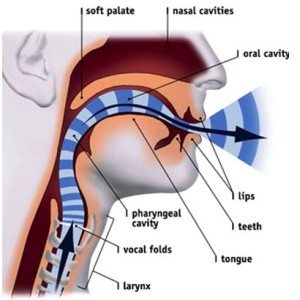
The sound produced by the vocal folds is a complex one consisting of a fundamental frequency, may harmonics and overtones. All voices have sound energy present over a wide variety of frequencies.
Resonation happens in the upper portion of the vocal tract, starting from above the larynx. When the tones from the larynx are resonated pharynx, they are recognized as human voice. The process of resonation allows us to produce different vowels. By changing the configuration of our throat, and mouth through movements of the tongue, lips and jaw a speaker can resonators that enhance the energy of the sound emanating from below.
Above the pharynx and the oral cavity, is the nasal cavity, which is a resonating chamber in its own. This is also largely responsible for altering the features of the glottal sound. It helps in the production of nasal sounds like – m,n and ng. We are born with the capacity to control the nasalization of our voice, unless a structural or functional defect is present ( cleft palate, submucous cleft)
